|
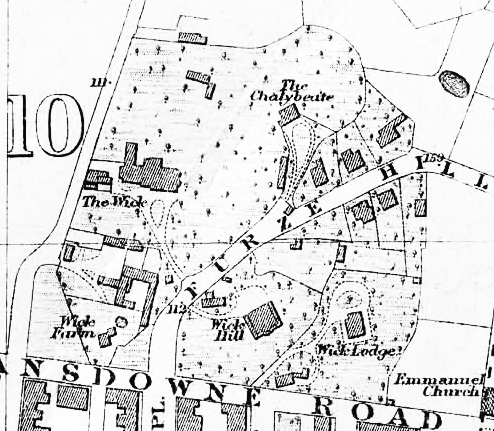 St Ann's Well Gardens St Ann's Well Gardens
George Albert Smith, who leased the pleasure gardens between 1892 and 1904, started making films around the turn of the year 1896-97. On the map the gardens are to the north-west of Furze Hill. Smith used the Pump House in the grounds ('The Chalybeate' on the map) as his 'film works' and at first built simple sets in the gardens [below].
 The future film comedian Tom Green probably began his connection with Smith as a set builder and decorator. That may be him up the step ladder. Hard to tell. Sets initially consisted of a painted backcloth on a wooden frame. In The Old Maid’s Valentine (1900) the message that the old maid holds up in her living room is blown about by the wind. In The Death of Poor Joe (1901) the shadows of the nearby trees are stippled on the snow covered garden gate and wall. Generally, although clearly artificial, the backdrops are competently executed.
The future film comedian Tom Green probably began his connection with Smith as a set builder and decorator. That may be him up the step ladder. Hard to tell. Sets initially consisted of a painted backcloth on a wooden frame. In The Old Maid’s Valentine (1900) the message that the old maid holds up in her living room is blown about by the wind. In The Death of Poor Joe (1901) the shadows of the nearby trees are stippled on the snow covered garden gate and wall. Generally, although clearly artificial, the backdrops are competently executed.
In 1900 Smith signed a two-year exclusive contract with the Warwick Trading Company (WTC), run by Charles Urban. He built a small studio in the grounds of St Ann’s Well Gardens with financial support from Urban. On the evidence of Poor Joe, which was made in March 1901, the studio was not in regular use until after that date. It consisted of a glasshouse over a stage measuring approximately 30 feet wide by 16 feet deep, with wooden doors forming one end of the building. The stage apron could be pulled forward between the doors.
|
|
In September 1900, the WTC catalogue describes Smith as ‘Manager of the Brighton Film Works of the Warwick Trading Company’.
 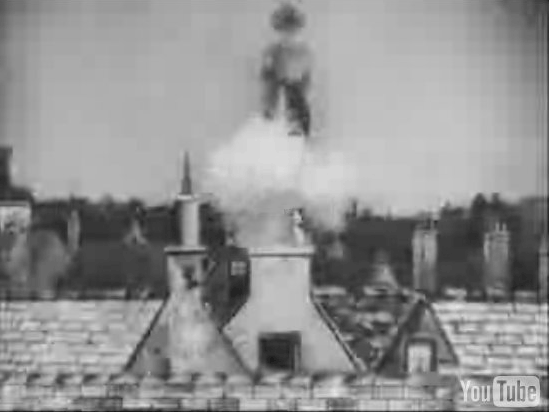
The rooftop set that can be seen on the stage [above left] appeared in Mary Jane's Mishap in a brief scene where Mary Jane shoots out of the chimney [above right].
Excursions into the immediate surroundings of St Ann’s Well Gardens were rare in Smith’s films; he preferred to shoot in studio conditions. However, As Seen Through a Telescope (1900) was filmed just outside the gardens, next to the Lodge in Furze Hill.
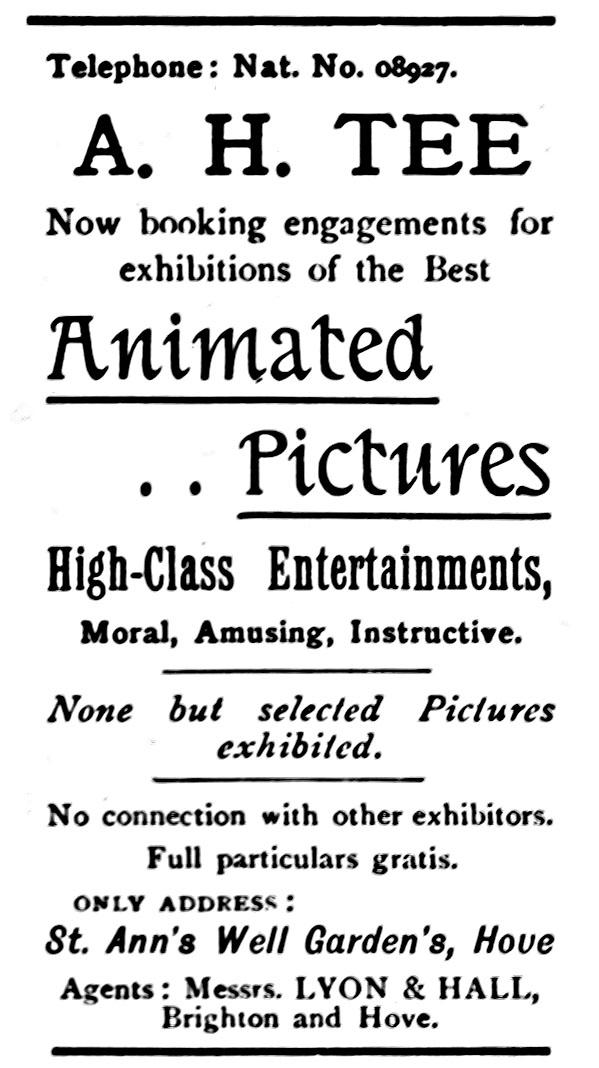 G A Smith left St Ann's Well Gardens in late 1903/early 1904 when he moved to Roman Crescent, Southwick to work on the colour film project that became Kinemacolor. The site was taken over by A H Tee, an entertainer. How much longer the studio lasted and its fate are unknown—it was not, after all, a particularly solid structure—but it must be assumed it did not outlast Smith's departure for very long. G A Smith left St Ann's Well Gardens in late 1903/early 1904 when he moved to Roman Crescent, Southwick to work on the colour film project that became Kinemacolor. The site was taken over by A H Tee, an entertainer. How much longer the studio lasted and its fate are unknown—it was not, after all, a particularly solid structure—but it must be assumed it did not outlast Smith's departure for very long.
St Ann’s Well Gardens was bought by Hove Borough Council for £10,000 in 1908 and became a public park. The pump house was demolished in 1935. The studio’s former presence in the park is marked by a Cinema 100 plaque on the entrance pillars on Somerhill Road but the exact location of the glasshouse structure has not been determined. |
|
Wilbury Villas
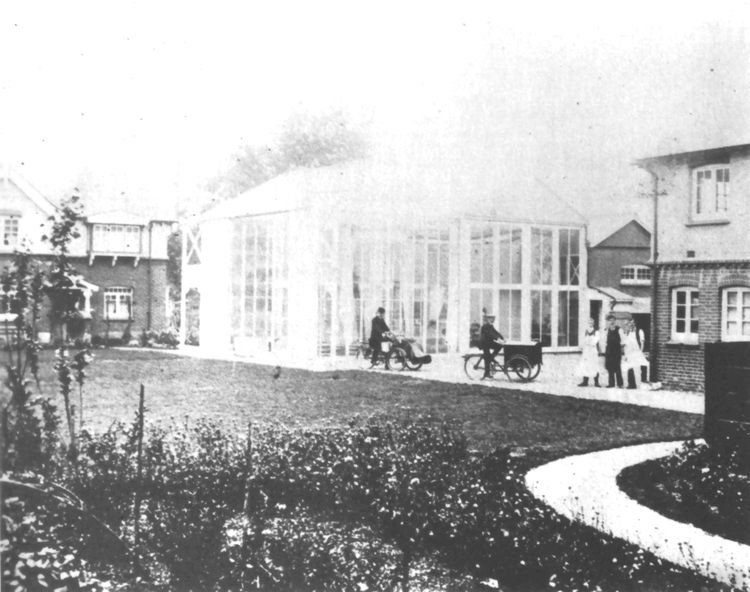
In 1902 James Williamson acquired a house called Rose Cottage next to the railway tracks, set back from the road just off the west side of Wilbury Villas. The Williamson family lived in Rose Cottage, which James called the foreman's cottage. That's him sitting on a chair on the path leading to the front door [right].
He used the land in front of it to build a glasshouse studio and added a second brick building, a 'photographic atelier', which abutted Giebeler's blind and shutter factory, known as the Oxford Works (now Paris House), alongside the approach to the bridge in Wilbury Villas.
The studio and atelier were designed by W B Sheppard, surveyor with offices in Southwick. A planning application filed with Hove Council on 20 March 1902 was rejected but a revised version was accepted on 17 April.The studio was built of wood and glass and was 25 ft high to the roof ridge. Overall it was about 25ft wide and 55ft long, the shooting area being about 40ft long, with a sliding door at one end. At the northern end were two dressing rooms. The atelier had a developing room, a photo print room and a laboratory store on the ground floor, a drying room, a scene loft, instrument room and office on the floor above. There was also a viewing theatre.
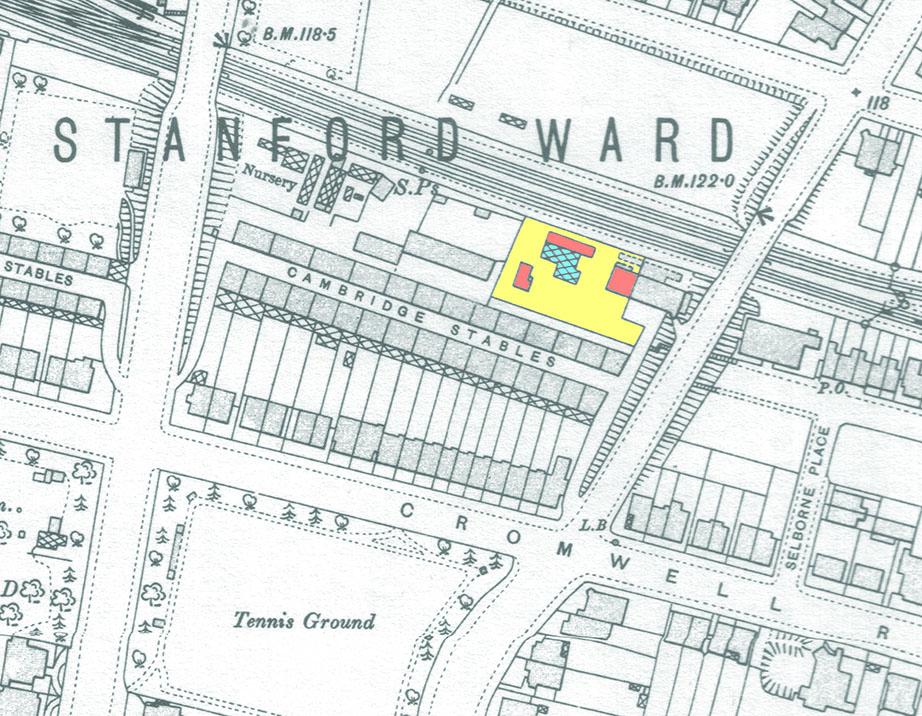
|
|
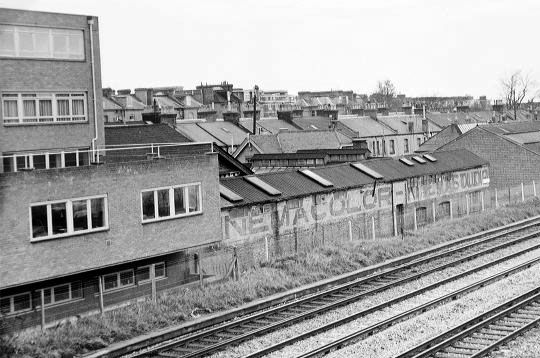 Between the studio and the railway line was a long single-storey brick shed. Stanley Mumford, who started worked here late in 1908, left a description of the site.
Between the studio and the railway line was a long single-storey brick shed. Stanley Mumford, who started worked here late in 1908, left a description of the site.
‘Mr Williamson showed me around the studio. ... Inside were stacks of scenery, doorways, window frames, fireplace, overmantels and plain flats; they were all painted in a rather contrasty, black and white distemper. The actual photography was done by daylight. I noticed there were muslin curtains ... that could be pulled over the sets should the sunlight become too hard.
‘The next building contained the props and was also used as a carpenter’s shop. Opposite the studio was another building, the lab where all the films were developed and printed. Nearby was the governor’s private house. ... Anybody standing around would be pulled into the picture, the producer often cobbled the whole story as he went along.’
Williamson quit film production in 1910 and the studio was taken over by Charles Urban's Natural Colour Kinematograph Company in 1910 to make Kinemacolor films. Urban paid £5,198 5s 0d for the freehold, plus £3,216 6s 3d for plant, fixtures and fittings. The name Kinemacolor was painted on the back of this building facing the tracks, and is still more or less visible, despite the graffiti. In 1914 the property was valued at £4,857.
On the Ordnance Survey map the glasshouse studio is coloured blue and the brick buildings in red. From left to right these are Rose Cottage, the ‘shed’ and the atelier. Around this time the shed appears to have been extended eastwards as it now extends across the north side of the atelier. It may be presumed that the extension was added by Charles Urban.
This is one of only two places in the city where ‘industrial’ buildings survive from the early days of the cinema.The area is now known as Cambridge Grove. The atelier, now called Cambridge House [below left] and occupied by a firm of solicitors, and the shed are the only parts Williamson's original site that survive. This building bears a Hove Borough Council plaque.
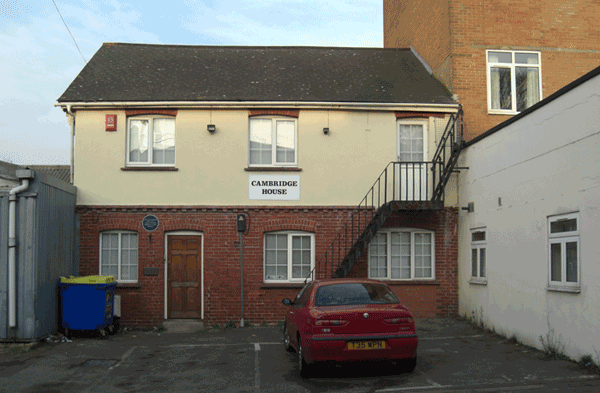 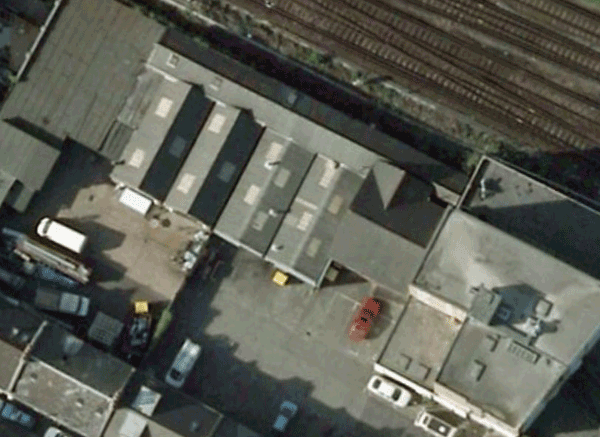 |
|
|
Shoreham Beach Film Studios

One of the last daylight studios in the country was built by F L Lyndhurst's Sealight Film Company in Crescent Road, Shoreham in 1915, close to the recently built Church of the Good Shepherd. It was a glasshouse structure with a floor area of 75 ft by 45 ft and a height of 30ft, built on a thick concrete base laid over the shingle.

The company had previously used the old fort at the mouth of the harbour as a studio [above}. The fort, which still exists in a ruined state, was built c.1790s as part of the nation’s defences against possible invasion by Napoleon, which were known as ‘Palmerston Follies’. It was used as a film ‘studio’ by Sunny South Film Company. Half a dozen films were made here in 1914-1915 featuring Arthur Conquest, Will Evans and Fred Evans—all screen versions of sketches well established from the stage.
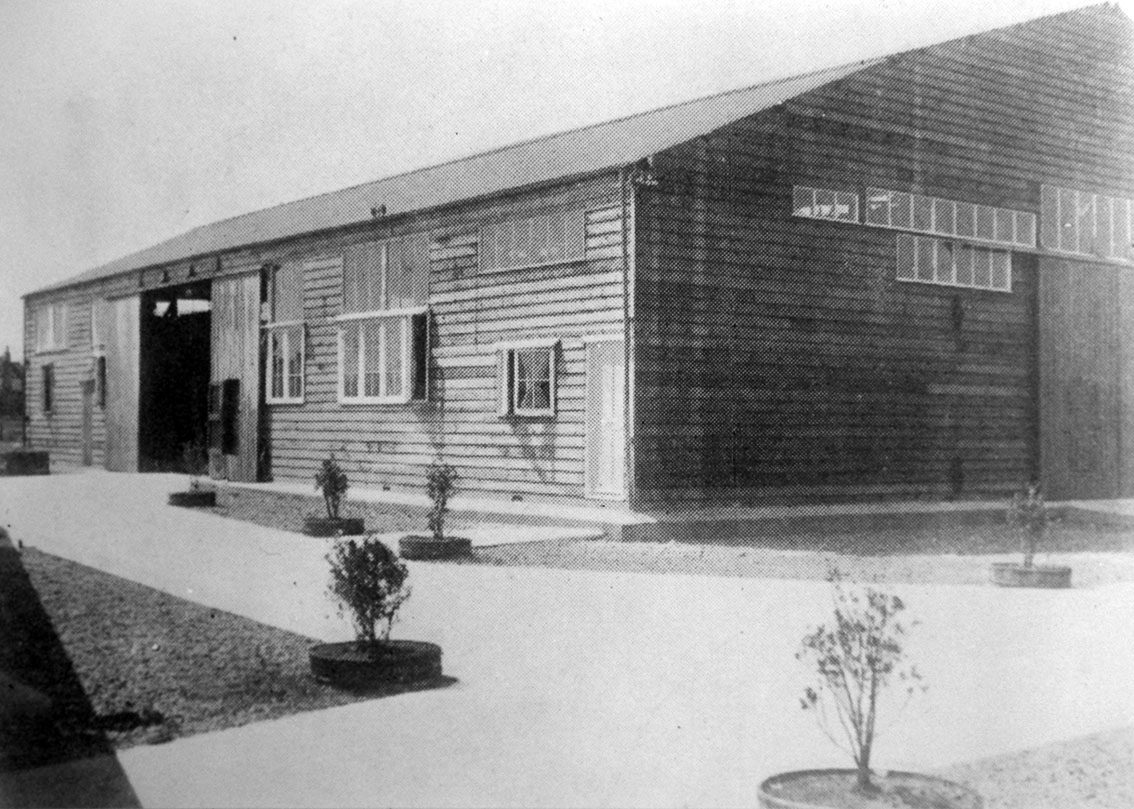

The studio had a joinery shop [above, top] and a rest chalet [above] where artistes could stay.
N E B Wolter's book Bungalow Town: Theatre and Film Colony has much more detail about the studio. It quotes an interview with Stanley Mumford: '[Shoreham was the only studio] in the country where the artists and key staff lived on the job. They had the time of their lives at the seaside studio; apart from hard work they made a regular holiday of it, so much so that when the picture was finished, the director could not get rid of them. They always wanted to stay a few days longer, what with parties, and sometimes a little gambling in the evening, apart from moonlight bathing, the sea being only 200 yards from the studio. You can guess they were not anxious to leave. Sidney Morgan and his daughter Joan were a delightful couple of work for, in fact the whole studio unit was a very happy crowd. We worked seven days a week and all through the holidays. From eight in the morning till seven in the evening, then dinner in the bungalow, afterwards talking about the day's work, or see the rushes of the previous day's takes.'
|
|
The area surrounding the studio had already become popular with film and music hall artistes and people with theatrical and film connections who built bungalows along Old Fort Road, many constructed from old railway carriages, brought across the river from the Lancing railway works, giving the name Bungalow Town to the area.

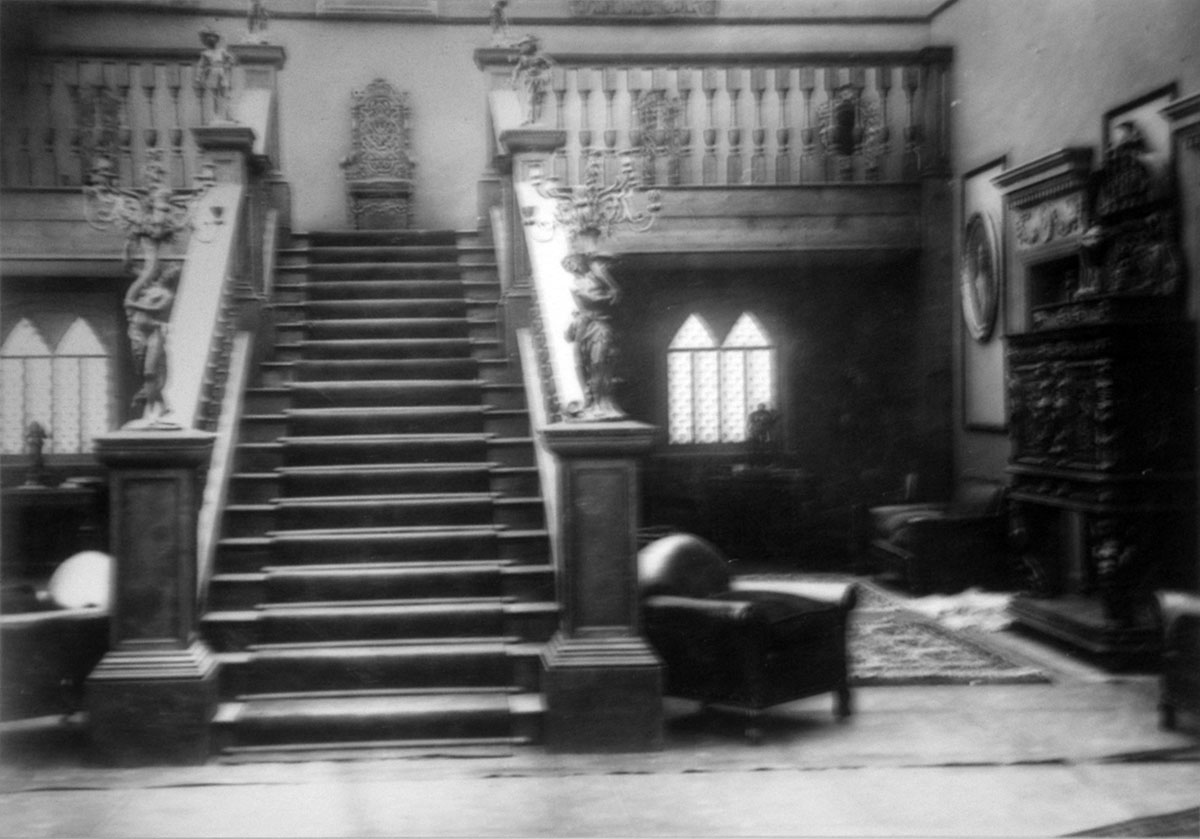
Wartime conditions mitigated against production and in 1916 Lyndhurst sold the studio to the Olympic Kine Trading Company, which sold it on again in 1918, without making any films, to Sidney Morgan's Progress Film Company. Other buildings were now added on the extended 1,000 square yard site for scenery construction, a preview theatre, stores and accommodation, and there was even a small film laboratory. It was by then the only studio in the country that did not use artificial light.
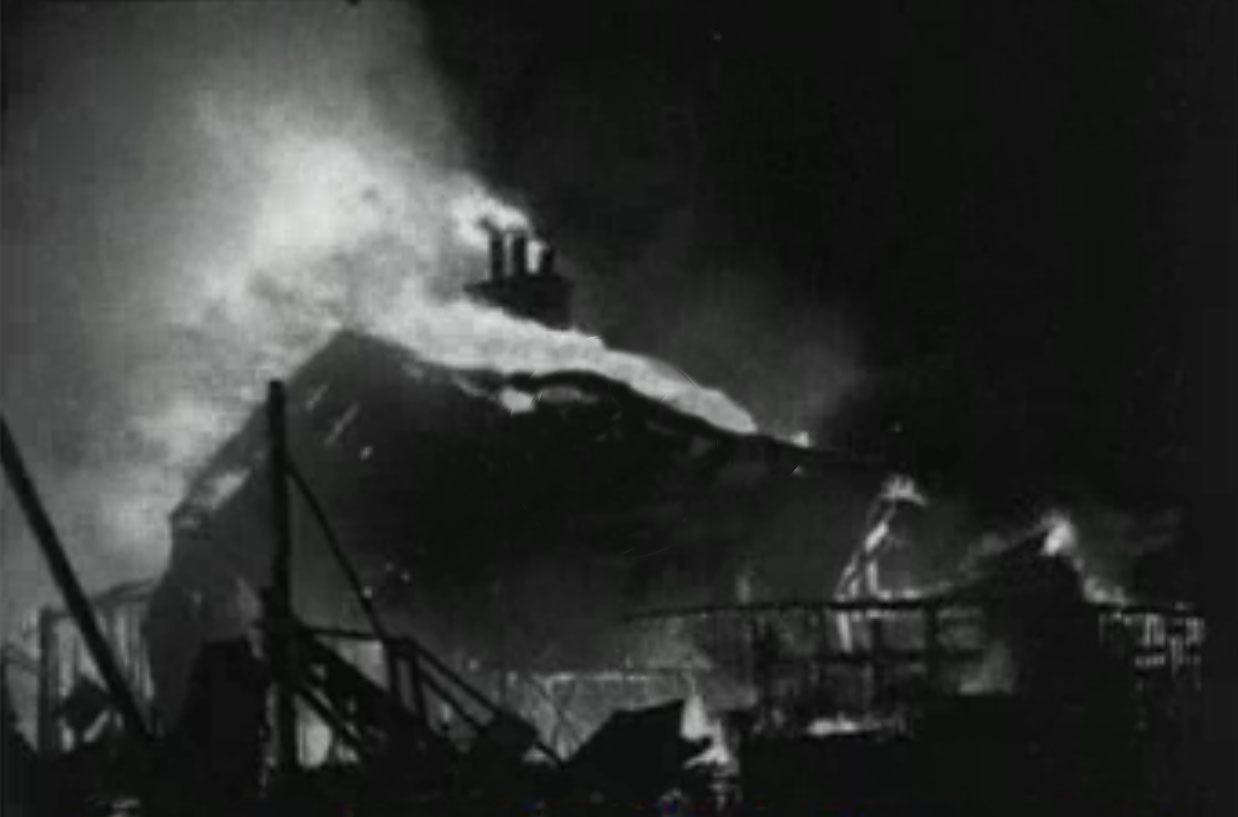 
A major fire destroyed a number of bungalows and other buildings in 1922. With his brother Arthur, Stanley Mumford, the cameraman with Progress Film Company, was able to remove the boxes of valuable but highly combustible negative from their bungalow and then filmed the blaze, which was included in the next edition of Pathé News.
The main studio building, although damaged, remained standing and was used by Walter West for two films. The Carlton Film Company moved in for a couple of films in 1923. But with that film-making in the area came to an end.
 A room in the studio's chalet for visiting artistes [right] and the viewing theatre [below]. A room in the studio's chalet for visiting artistes [right] and the viewing theatre [below].

|
|
|
Brighton Film Studios
 Between 1948 and 1966 Brighton Film Studios occupied a large red-brick building of 1880 between St Nicholas Road and Centurion Road, which had previously been the St Nicholas Parish Rooms and Sunday School and, briefly after the Second World War, the Brighton Auction Sale Rooms. The studios were formally opened in September 1948 by comedian Sid Field and contained two studio spaces. One measured 75ft x 40ft, the other 60ft x 40ft, both with RCA sound recording facilities. Between 1948 and 1966 Brighton Film Studios occupied a large red-brick building of 1880 between St Nicholas Road and Centurion Road, which had previously been the St Nicholas Parish Rooms and Sunday School and, briefly after the Second World War, the Brighton Auction Sale Rooms. The studios were formally opened in September 1948 by comedian Sid Field and contained two studio spaces. One measured 75ft x 40ft, the other 60ft x 40ft, both with RCA sound recording facilities.
Film Studios (Brighton) Ltd was formed to run the facility in parallel with the occasional in-house production company. Management changed at regular intervals. The first managing director was an experienced film industry figure, Jack Norman. Around 1952/53 the managing director was Charles Reynolds (real name Rinaldo Walter Reynolds Romegialli), whose own production company made seven B-features but may have used the Brighton facilities only once, if that. Also on the board were R Lionel Tomlinson, the studio’s production manager, and R I Gridley. The studio controller was Herbert Wynne.
Advertising itself as available for ‘first and second features—advertising and commercial films’, it was one of half a dozen studios in the south of England that served the low-budget market. Almost a score of feature films—mainly crime and thrillers and usually released as B features, supporting more prestigious productions in the cinema (if they got into cinemas at all)—were made at Brighton Film Studios between 1949 and 1964 . It was also used to shoot occasional short and industrial films, plus television commercials in the early days of ITV.
A production company was formed in 1945 but the first feature film was not made until 1949. The Adventures of Jane was produced and directed by Edward G Whiting, who co-wrote it with Alfred Goulding and Con West.
Tomlinson’s RLT Productions was based at the studios around 1953. Tomlinson and Baron Nugent were on the production company’s board with Derrick C Wynne. Wynne and Tomlinson produced the company’s one film, Take a Powder (1953). Tomlinson and Gridley remained on the board of the studio company, joined by W Wolstenholme, when Reynolds was replaced as MD by Derrick Wynne c1953 and the studios’ fortunes improved.
|
|
Wynne and Nugent were also the directors of Wynne Productions Ltd with a production office at the studio and a registered office at 43 Church Road, Hove. Nugent went off to Hollywood to feature in a TV series in January 1956, when he told film critic Judith Crist of the New York Herald Tribune: ‘My interests in England are entirely bound up in the film business. I own a film studio whose sale I’m negotiating and I have two production companies working on commercial television.’ He must have achieved his goal as far as the studio was concerned because by 1957 his place on the board was taken by B S Chadwick.
At the end of 1953 the studio had eight technical staff, 12 in craft grades and seven clerical and other employees. As the volume of production increased, so did the number of staff: from 27 in 1953 to 45 in 1955—the peak year for production—down to 25 in 1956, then back up to 33 in 1957 and as many as 47 in 1958.
By 1958 Crest Film Productions Ltd was also listed at the studios and was identified as the lessee in 1961 but this company appears to have ceased functioning by 1962 and it is not known whether it ever made any films using the facilities in Brighton.
Writer/producer Brandon Fleming was the most regular user of the studios. His first film there was Solution by Phone in 1953 for Pan Productions, which was again the production company when he returned in 1955 for Alive on Saturday but The Gelignite Gang (1954) and Alias John Preston (1955) were for other companies. It was by no means uncommon for a company to be formed for a single film, to avoid the debts of one film contaminating the prospects for the next production.
Anthony Young was the first director to come back more than once, bringing the second and third features to the shooting stages at Brighton. Another returnee—and probably the best director who worked here—was Cy Endfield, a refugee from the Hollywood witch-hunts, who used the studios twice in 1955, for The Master Plan (with limited location work at Stanmer) and The Secret (more extensive location shooting around Brighton and Telscombe).
It is a shame that what was perhaps the best film made at the Brighton Film Studios was also the last, a witty and entertaining crime story called Smokescreen (1964). It showed what could come out of a small provincial studio.
The studio continued to be listed in the Kine Year Book until at least 1970 but that says more about the lack of proper revision of reference books than it does about the availability of the facilities in Brighton. The building again became an auction house after the studio closed and was converted into flats in 1987.
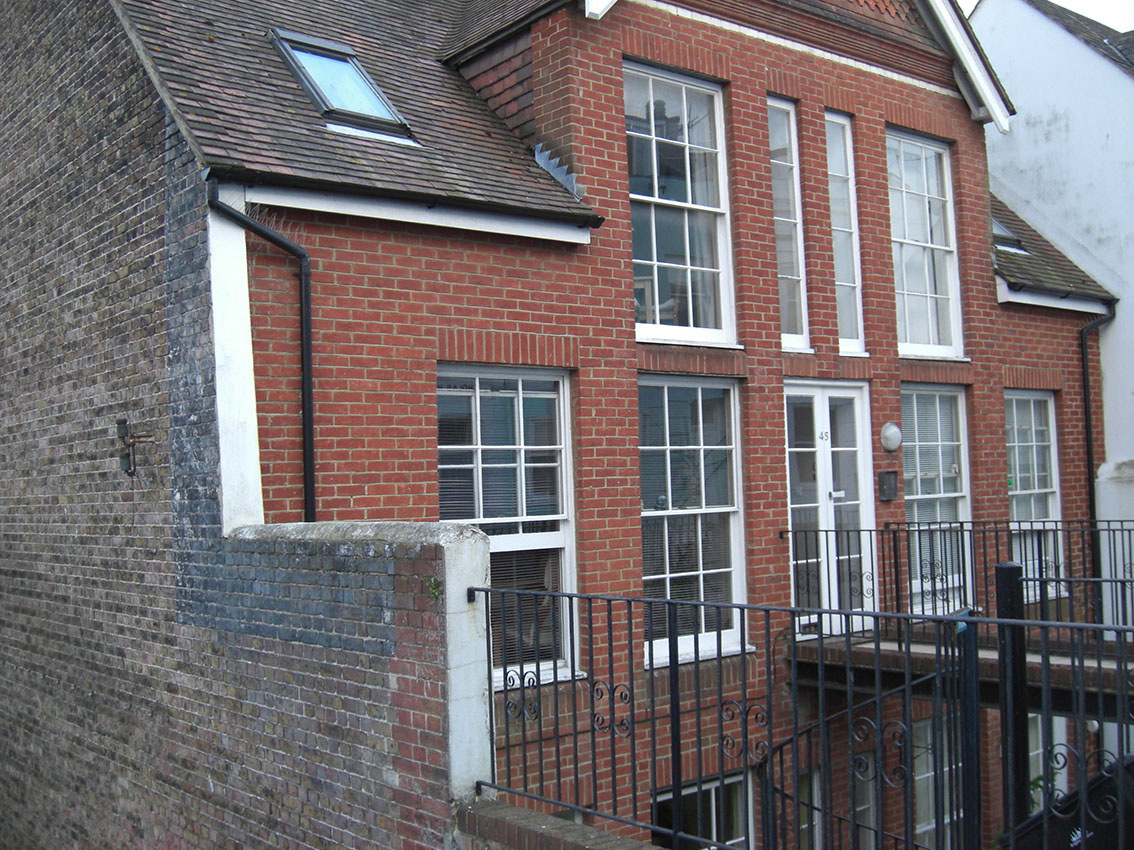
The entrance to the former studios in St Nicholas Road |







